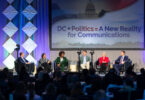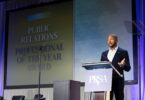As change and social polarization buffet companies, “I think this is an incredible time for communicators,” said Barby K. Siegel. “There is a lot of uncertainty and divisiveness in organizations. But over the last five years, our craft has evolved from being an isolated function to now being a strategic business imperative.”
Siegel, CEO of Zeno Group, was among the panelists on Nov. 6 for “Leading the Narrative: CCOs and CEOs on What’s Next for PR,” the keynote conversation of FutureCon, PRSA’s new, virtual summit for management- and executive-level communicators.
As PR leaders, “We not only have a seat at the table, but we are setting the table,” Siegel said. “Communications is now embedded across the entire organization, no longer a bolt-on. We as communicators need to come to our role as business leaders.”
Panelist Jonathan Heit, CEO of Allison Worldwide, said he shares “the same optimistic view of where things are headed” in the PR profession.
As artificial intelligence upends traditional approaches to communication, “You need all the same skills you’ve always needed, but you also have to be fluent and conversant in data analytics,” Heit said. “Our industry has always been very good at looking at sentiment and understanding what’s happening now. But you have to be better than ever at working with your team to understand what’s coming next.”
Matthew Marcial, CAE, PRSA’s CEO, moderated the panel. He asked how communications leaders can navigate today’s volatile environment.
The way to approach uncertainty is to mitigate and minimize it, Heit said. He recommends “mapping the emotional intensity” of data to predict when a particular story or issue could escalate for a company. “Being able to communicate that [insight] to stakeholders, CEOs, and boards is more important than ever,” he said.
Panelist Teneshia Jackson Warner is the founder and CEO of EGAMI Group, a communications firm. “As a multicultural communicator advising global brands on how to reach multicultural audiences, if I look at where we were in 2020, and where we are now, it’s a 180-degree turn,” she said. “How did we go between these extremes this fast?”
In 2020, she received calls from clients seeking help in communicating to the world that they supported multicultural audiences. Today, clients say, “‘We want to continue the course, but we do not want to be called out or thrown into a political environment,’” she said. “The strategies that worked then no longer work now.”
Jackson Warner said her agency encourages communicators to have “cultural competence” across the public relations function, before sending out any messages.
Communications partnership with the CEO
Panelist Stephanie Roberts is chief communications officer for Hitachi Industrial Equipment Systems. She said today’s relationship between a CEO and CCO should be a partnership.
“I think the CCO’s role has really escalated” in the fraught social and political climate of recent years, she said. “The CCO is one of the few people within a company who has that 360-degree view. We are not silos. We are working with every single function.”
A chief communications officer “can provide that input to the CEO based on the realities of what’s happening internally with employees, and what’s happening with the culture, that external perception” of a company.
To communicate such intelligence to the chief executive, “We have to be willing to be that truth-teller, to bring that unvarnished truth to the CEO, that not-always-positive feedback,” Roberts said. “That’s a tough part of the job. But if we see something that might blow up later, or cause backlash or negative sentiment, we have to be able to tell that to the CEO.”
And to predict and communicate business risks, Roberts said, “We need to be involved with the strategy from the start.”
Illustration credit: Friedbert







